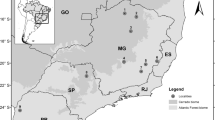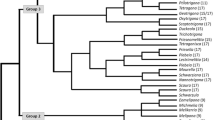Abstract
Most Lepidoptera have a WZ/ZZ sex chromosome system. We compared structure of W chromosomes in four representatives of the family Pyralidae—Ephestia kuehniella, Cadra cautella, Plodia interpunctella, and Galleria mellonella—tracing pachytene bivalents which provide much higher resolution than metaphase chromosomes. In each species, we prepared a W-chromosome painting probe from laser-microdissected W-chromatin of female polyploid nuclei. The Ephestia W-probe was cross-hybridized to chromosomes of the other pyralids to detect common parts of their W chromosomes, while the species-specific W-probes identified the respective W chromosome. This so-called Zoo-FISH revealed a partial homology of W-chromosome regions between E. kuehniella and two other pyralids, C. cautella and P. interpunctella, but almost no homology with G. mellonella. The results were consistent with phylogenetic relationships between the species. We also performed comparative genomic hybridization, which indicated that the W chromosome of C. cautella is composed mainly of repetitive DNA common to both sexes but accumulated in the W chromosome, whereas E. kuehniella, P. interpunctella, and G. mellonella W chromosomes also possess a large amount of female specific DNA sequences, but differently organized. Our results support the hypothesis of the accelerated molecular divergence of the lepidopteran W chromosomes in the absence of meiotic recombination.
Similar content being viewed by others
References
Abe H, Sugasaki T, Terada T et al. (2002) Nested retrotransposons on the W chromosome of the wild silkworm Bombyx mandarina. Insect Mol Biol 11: 307–314.
Abe H, Mita K, Yasukochi Y, Oshiki T, Shimada T (2005) Retrotransposable elements on the W chromosome of the silkworm, Bombyx mori. Cytogenet Genome Res 110: 144–151.
Al-Taweel AA, Ahmed MSH, Kadhum SS, Hameed AA (1990) Effects of gamma radiation on the progeny of irradiated Ephestia cautella (Walker) (Lepidoptera: Pyralidae) males. J Stored Prod Res 26: 233–236.
Arunkumar KP, Metta M, Nagaraju J (2006) Molecular phylogeny of silkmoths reveals the origin of domesticated silkmoth, Bombyx mori from Chinese Bombyx mandarina and paternal inheritance of Antheraea proylei mitochondrial DNA. Mol Phyl Evol 40: 419–427.
Bachtrog D (2006) A dynamic view of sex chromosome evolution. Curr Opin Genet Dev 16: 578–585.
Charlesworth B, Charlesworth D (2000) The degeneration of Y chromosomes. Philos Trans R Soc Lond B Biol Sci 355: 1563–1572.
Charlesworth D, Charlesworth B, Marais G (2005) Steps in the evolution of heteromorphic sex chromosomes. Heredity 95: 118–128.
Devlin RH, Stone GW, Smailus DE (1998) Extensive direct-tandem organization of a long repeat DNA sequence on the Y chromosome of Chinook salmon (Oncorhynchus tshawytscha). J Mol Evol 46: 277–287.
Ellegren H, Carmichael A (2001) Multiple and independent cessation of recombination between avian sex chromosomes. Genetics 158: 325–331.
Fuková I, Nguyen P, Marec F (2005) Codling moth cytogenetics: karyotype, chromosomal location of rDNA, and molecular differentiation of sex chromosomes. Genome 48: 1083–1092.
Fuková I, Traut W, Vítková M, Nguyen P, Kubíčková S, Marec F (2007) Probing the W chromosome of the codling moth, Cydia pomonella, with sequences from microdissected sex chromatin. Chromosoma 116: 135–145.
Graves JAM (2006) Sex chromosome specialization and degeneration in mammals. Cell 124: 901–914.
Grimaldi D, Engel MS (2005) Evolution of the Insects. New York: Cambridge University Press.
Gvozdev VA, Kogan GL, Usakin LA (2005) The Y chromosome as a target for acquired and amplified genetic material in evolution. BioEssays 27: 1256–1262.
Handley LL, Ceplitis H, Ellegren H (2004) Evolutionary strata on the chicken Z chromosome: implications for sex chromosome evolution. Genetics 167: 367–376.
Koike Y, Mita K, Suzuki MG et al. (2003) Genomic sequence of a 320-kb segment of the Z chromosome of Bombyx mori containing a kettin ortholog. Mol Genet Genomics 269: 137–149.
Kubickova S, Cernohorska H, Musilova P, Rubes J (2002) The use of laser microdissection for the preparation of chromosome-specific painting probes in farm animals. Chromosome Res 10: 571–577.
Lukhtanov VA (2000) Sex chromatin and sex chromosome systems in nonditrysian Lepidoptera (Insecta). J Zoolog Syst Evol Res 38: 73–79.
Mandrioli M, Manicardi GC, Marec F (2003) Cytogenetic and molecular characterization of the MBSAT1 satellite DNA in holokinetic chromosomes of the cabbage moth, Mamestra brassicae (Lepidoptera). Chromosome Res 11: 51–56.
Marec F (1996) Synaptonemal complexes in insects. Int J Insect Morphol Embryol 25: 205–233.
Marec F, Traut W (1994) Sex chromosome pairing and sex chromatin bodies in W-Z translocation strains of Ephestia kuehniella (Lepidoptera). Genome 37: 426–435.
Matsubara K, Tarui H, Toriba M et al. (2006) Evidence for different origin of sex chromosomes in snakes, birds, and mammals and step-wise differentiation of snake sex chromosomes. Proc Natl Acad Sci USA 103: 18190–18195.
Mediouni J, Fuková I, Frydrychová R, Dhouibi MH, Marec F (2004) Karyotype, sex chromatin and sex chromosome differentiation in the carob moth, Ectomyelois ceratoniae (Lepidoptera: Pyralidae). Caryologia 57: 184–194.
Ostrjakowa-Warschaver WP (1937) Die grosse Wachsmotte Galleria mellonella L. als neues Objekt für genetische Untersuchungen. I. Einige Angaben über Biologie, Morphologie, Genetik, und Züchtungsmethoden [in Russian, German abstract]. Biol Zh 6: 797–815.
Phillips RB, Konkol NR, Reed KM, Stein JD (2001) Chromosome painting supports lack of homology among sex chromosomes in Oncorhynchus, Salmo, and Salvelinus (Salmonidae). Genetica 111: 119–123.
Rubes J, Kubickova S, Musilova P, Amaral ME, Brunner RM, Goldammer T (2005) Assignment of chromosome rearrangements between X chromosomes of human and cattle by laser microdissection and Zoo-FISH. Chromosome Res 13: 569–574.
Sahara K, Marec F, Eikhoff U, Traut W (2003a) Moth sex chromatin probed by comparative genomic hybridization (CGH). Genome 46: 339–342.
Sahara K, Yoshido A, Kawamura N et al. (2003b) W-derived BAC probes as a new tool for identification of the W chromosome and its aberrations in Bombyx mori. Chromosoma 112: 48–55.
Schartl M (2004) Sex chromosome evolution in non-mammalian vertebrates. Curr Opin Genet Dev 14: 634–641.
Scherthan H, Cremer T, Arnason U, Weier HU, Lima-de-Faria A, Frönicke L (1994) Comparative chromosome painting discloses homologous segments in distantly related mammals. Nat Genet 6: 342–347.
Schulz HJ, Traut W (1979) The pachytene complement of the wildtype and a chromosome mutant strain of the flour moth, Ephestia kuehniella (Lepidoptera). Genetica 50: 61–66.
Shetty S, Griffin DK, Graves JAM (1999) Comparative painting reveals strong chromosome homology over 80 million years of bird evolution. Chromosome Res 7: 289–295.
Skaletsky H, Kuroda-Kawaguchi T, Minx PJ et al. (2003) The male-specific region of the human Y chromosome is a mosaic of discrete sequence classes. Nature 423: 825–837.
Solis MA, Mitter C (1992) Review and preliminary phylogenetic analysis of the subfamilies of the Pyralidae (sensu stricto) (Lepidoptera, Pyraloidea). Syst Entomol 17: 79–90.
Steinemann M, Steinemann S (2005) Y chromosomes: born to be destroyed. BioEssays 27: 1076–1083.
Steinemann M, Steinemann S, Lottspeich F (1995) How Y chromosomes become genetically inert. Proc Natl Acad USA 90: 5737–5741.
Traut W (1976) Pachytene mapping in the female silkworm, Bombyx mori L. (Lepidoptera). Chromosoma 58: 275–284.
Traut W (1999) The evolution of sex chromosomes in insects: differentiation of sex chromosomes in flies and moths. Eur J Entomol 96: 227–235.
Traut W, Marec F (1996) Sex chromatin in Lepidoptera. Q Rev Biol 71: 239–256.
Traut W, Marec F (1997) Sex chromosome differentiation in some species of Lepidoptera (Insecta). Chromosome Res 5: 283–291.
Traut W, Sahara K, Otto TD, Marec F (1999) Molecular differentiation of sex chromosomes probed by comparative genomic hybridization. Chromosoma 108: 173–180.
Traut W, Eickhoff U, Schorch JC (2001) Identification and analysis of sex chromosomes by comparative genomic hybridization (CGH). Methods Cell Sci. 23: 157–163.
van’t Hof AE, Zwaan BJ, Saccheri IJ, Daly D, Bot ANM, Brakefield PM (2005) Characterization of 28 microsatellite loci for the butterfly Bicyclus anynana. Mol Ecol Notes 5: 169–172.
Vyskot B, Hobza R (2004) Gender in plants: sex chromosomes are emerging from the fog. Trends Genet 20: 432–438.
Wang YX, Marec F, Traut W (1993) The synaptonemal complex complement of the wax moth, Galleria mellonella. Hereditas 118: 113–119.
Yoshido A, Yasukochi Y, Marec F, Abe H, Sahara K (2007) FISH analysis of the W chromosome in Bombyx mandarina and several other species of Lepidoptera by means of B. mori W-BAC probes. J Insect Biotech Sericol 76: 1–7.
Author information
Authors and Affiliations
Corresponding author
Rights and permissions
About this article
Cite this article
Vítková, M., Fuková, I., Kubíčková, S. et al. Molecular divergence of the W chromosomes in pyralid moths (Lepidoptera). Chromosome Res 15, 917–930 (2007). https://doi.org/10.1007/s10577-007-1173-7
Received:
Revised:
Accepted:
Published:
Issue Date:
DOI: https://doi.org/10.1007/s10577-007-1173-7




